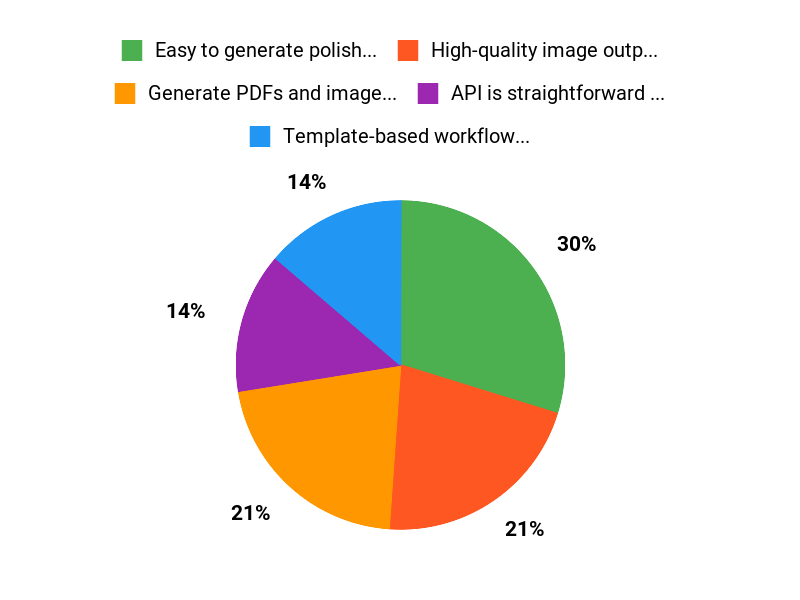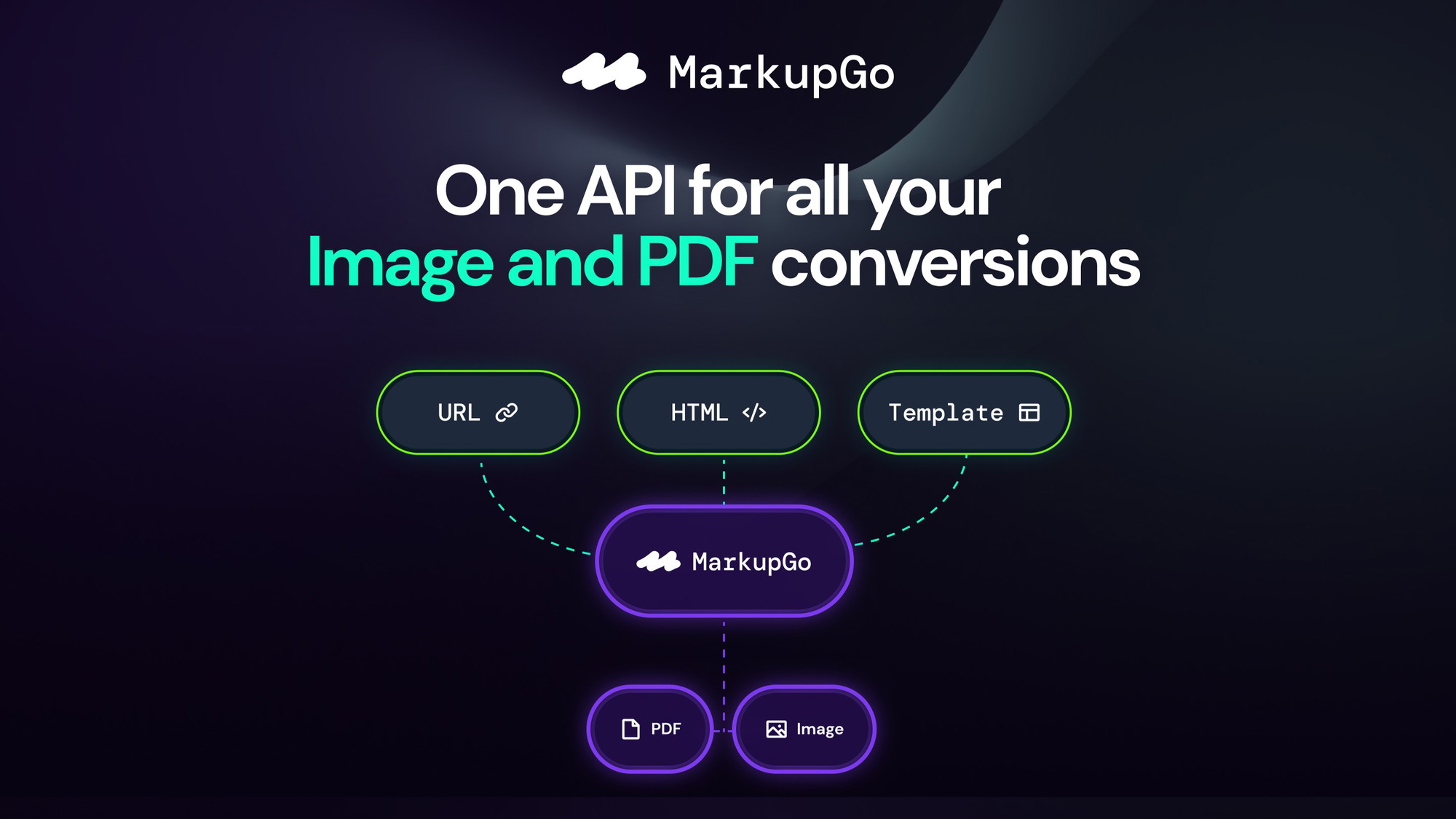You handle images and PDFs more than you think — from marketing assets to automated reports — and manual processes slow you down. MarkupGo gives you a single API to generate high-quality images and PDFs from URLs, HTML, CSS, and JavaScript templates so you can standardize output, reduce repetitive work, and ship faster.
If you’re evaluating an LTD for Image and PDF tools, MarkupGo stands out for its template flexibility, straightforward API, and an AppSumo deal available at $49 that makes it easy to test without a big up-front commitment.
TL;DR
Feature | Verdict |
|---|---|
Ease of Use | ⭐️⭐️⭐️⭐️⭐️ – Smooth API and simple templates; you can get basic automations running quickly ⏱️ |
Automation & Templates | ⭐️⭐️⭐️⭐️ – Powerful HTML/CSS/JS templating for dynamic PDFs and images; great for repeatable reports 🎨 |
Output Quality | ⭐️⭐️⭐️⭐️⭐️ – Consistent, high-quality renders suitable for marketing, reporting, and assets 🔍 |
Performance | ⭐️⭐️⭐️ – Reliable but sometimes 3–4s per request; fine for many workflows but consider bulk needs ⏱️ |
Integrations & API | ⭐️⭐️⭐️⭐️ – Full API access and image-transformation endpoints make it easy to plug into your stack 🔌 |
MarkupGo
If you need a simple way to automate image and PDF generation, MarkupGo makes it easy to turn HTML, URLs, or templates into consistent outputs. You can use HTML, CSS and JavaScript templates, stitch images together, or auto-generate reports for clients.
For daily tasks it speeds up repetitive work like creating social posts or weekly reports; for special projects it helps you produce polished client deliverables without juggling different tools. If you’re hunting for an LTD for Image and PDF tools, MarkupGo is a practical pick — it’s straightforward to plug into your workflow, and you’ll notice the time savings fast.
The platform shines when you want reliable, template-driven outputs and fewer manual steps.
Pros and Cons
Pros | Cons |
|---|---|
✅ Easy to generate polished PDFs and images from templates | ❌ Request processing can be 3–4+ seconds under load |
✅ High-quality image outputs that suit marketing and reports | ❌ PDF download credit usage isn’t super obvious at first |
✅ API is straightforward to integrate into automation |
What People Say
People say it’s a reliable, time-saving API that’s great for agencies and freelancers—excellent image quality and handy template features, with some notes about request speed and credit visibility.
Overall Sentiment: Positive
![]()
🗣️ Codigo6
If you work in an agency or as a freelancer, you’ll appreciate how it generates posts and reports quickly, produces standout images compared to pricey image services, and helped one user replace costly DALL‑E spends; note they mentioned PDF download credits weren’t obvious at first.
🗣️ LeadingChange
You’ll get clean, high-quality image outputs and flexible templates. One reviewer used it to combine images and auto-generate PDFs—setup took about an hour—and called the platform smooth, though they and others noted request times can be around 3–4 seconds in some cases.
Situational Benefits
Situation | How It Helps |
|---|---|
Daily Reports | Automates report generation from templates so you can publish consistent PDFs without manual layout work. |
Social Posts | Combine images and templates to produce on‑brand visuals quickly for scheduled posts. |
Client Deliverables | Create reproducible, high-quality PDFs for proposals and deliverables using the same templates every time. |
Automated Workflows | Plug the API into your existing automation stack to remove manual steps in image and document pipelines. |
Ease Of Use
Feature | Ease Level |
|---|---|
API Setup | Easy |
Templates (HTML/CSS/JS) | Easy |
Image Transformations | Moderate |
PDF Generation | Easy |
Usability
Aspect | Ease Level | Notes |
|---|---|---|
Integration | Easy | REST API fits into common stacks and automation tools. |
Template Flexibility | Easy | Use HTML/CSS/JS to create complex layouts and dynamic content. |
Learning Curve | Moderate | Basic use is quick, advanced templating may require HTML/CSS skills. |
Documentation | Good | Enough to get started and integrate common workflows. |
Performance & Speed
Generally reliable but expect typical request times around 3–4 seconds; occasional requests can be slower under heavy load.
Integrations
Software | Integration Quality |
|---|---|
REST API / Webhooks | Excellent |
Automation Tools | Good |
CMS and Publishing Tools | Good |
Custom Backends | Excellent |
Collaboration Features
You can build shared templates and fold outputs into team workflows via the API; this makes it straightforward to standardize documents across a team.
Key Benefits
- Generate PDFs and images from URLs or HTML templates
- Template-based workflow with HTML, CSS and JavaScript
- Saves time on repetitive image/report production
- Good image quality suitable for marketing and reports
- API-first design fits into automated workflows
Rating: 4.94 (total: 33+)
FAQ
What Is MarkupGo And Who Is It Best Suited For?
MarkupGo is an all-in-one API that helps you automate image and PDF generation from URLs, HTML, CSS, and JavaScript templates. If you’re juggling repetitive document or image tasks, you’ll appreciate that it gives you a single, powerful API to produce consistent, high-quality outputs.
It’s particularly well suited for developers, agencies, freelancers, and anyone building automation into marketing, reporting, or publishing workflows. If you’re looking for an LTD for Image and PDF tools, MarkupGo is designed to be that kind of time-saver and workflow consolidator.
How Easy Is It To Integrate And What About Performance?
You can get started quickly because the API is straightforward and supports HTML/CSS/JS templates so you don’t need to rebuild your designs from scratch. Expect to prototype in minutes and integrate into backend jobs or serverless functions with standard HTTP requests.
Real-world performance can vary; some users report typical request times around a few seconds per render, and the team is working on speed improvements. To keep things fast on your side, pre-render or cache frequently used assets, batch requests where possible, keep templates lightweight, and run image generation asynchronously so you don’t block user-facing flows.
What Should I Consider Before Buying And Any Practical Tips For Daily Use?
Before you commit, think about how many renders you’ll need, the number of templates you plan to maintain, and how you’ll handle credits and quotas in production. Be aware that some actions, like downloading PDFs in specific setups, may consume credits, so monitor usage early to avoid surprises. For daily use, test with realistic sample jobs, set up retry and timeout logic, cache static outputs, and optimize templates to reduce render time and cost. Also check API docs for rate limits, security practices, and data handling so you can meet compliance needs.
These steps will help you scale smoothly and get the most value from an LTD for Image and PDF tools like MarkupGo.
Why Choose MarkupGo
You choose MarkupGo because it automates tedious image and PDF markup with an intuitive interface and a simple API, so you can eliminate manual work and get tasks done much faster. It also fits into your existing workflow with templates, batch processing, and reliable output, giving you consistent, scalable results so you can focus on higher-value work.

Wrapping Up
You save time and reduce errors when you centralize image and PDF generation. MarkupGo gives you a single, template-driven API for high-quality output and a developer-friendly integration path.
The platform is best if you need consistent, repeatable renders for reports, marketing assets, or automated workflows; performance can vary (often 3–4 seconds per request), so test it with your expected volume. If you’re evaluating LTD for Image and PDF tools, MarkupGo’s combination of templates, full API access, and the $49 entry price makes it a practical option to try and integrate into your stack.
This Article is reader-supported. When you click through links we may earn a referral commission on qualifying purchases.


